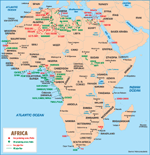|
Aug.
2001 Vol. 222 No. 8
International Outlook
|
AFRICA
Nigeria
Nigeria is Africa’s leading oil producer,
dependent on oil exports for 80% of all government revenue and over 90% of all export revenue. Officials have
begun a gradual, phased-in privatization of many businesses. Domestic growth was roughly 3% in 2000, and that
rate may accelerate. Political unrest and sabotage of petroleum infrastructure remain a problem.
More than two years after the country returned to
civilian rule, Nigeria continues to amend its hydrocarbon laws. Reforms to the 1990 Petroleum Act concern
dozens of issues, including federal vs. state ownership of minerals and the federal / state allocation of oil
revenues. In January 2001, President Olusegun Obasanjo replaced his entire cabinet.
Last September, Nigeria and Equatorial Guinea formally
settled their long-running maritime border dispute. Equatorial Guinea held onto the Zafiro oil complex, while
Nigeria gained acreage farther south. Sao Tome and Principe agreed with Nigeria to jointly develop and manage
a disputed area between their offshore borders. Oil was discovered there recently but not appraised.
Exploration. About half of the deepwater wells
drilled have struck pay, with combined reserves estimated at 5.6 billion bbl. Nigeria’s first tender
offer closed in December, selling eight of 22 leases offered to consortia that involve 14 oil companies.
Allegations of corruption continue, although it was an
improvement from past lease sales under military rule. Winners included Exxon (OPL214); Amni (OPL229); Obekpa
(OPL242); Eni (OPL244); Petrobrás (OPL324); Oranta (OPL320); Chevron (OPL250); and Phillips (OPL244).
The tender raised $900 million for the government.
Drilling / development. Several giant deepwater
discoveries will significantly increase production as they come onstream. Chief among them is ExxonMobil’s
Erha field (1.2 billion bbl in estimated reserves); output could reach 250,000 bopd by 2003 – 2004.
Texaco’s Agbami field (estimated reserves exceed 1
billion boe) is scheduled to go online in 2004, with a production capacity of 200,000 bpd of 45°API sweet
crude. Shell’s Bonga field is expected online in late 2003, as is the firm’s EA/EJA field. Bonga
should produce about 225,000 bopd and 170 MMcfgd. Bonga’s development will require 29 subsea trees (some
for water injection) connected to an FPSO, with a gas export line extending to the EA riser platform.
EA/EJA, a "small," 350-MMbbl shallow-water
discovery, will produce 120,000 bopd from 54 producer wells. It should see first oil by year-end 2002.
TotalFinaElf’s Amenam / Kpono field has 500 MMbbl of estimated reserves and is expected to begin
producing 100ý000 bopd in summer 2003. Production will begin this year from Eni/Agip’s Abo field,
while TotalFinaElf’s Amenam / Kpono field should yield 100,000 bopd by mid-2003. Nigerian National
Petroleum Corp. (NNPC) and Eni/Agip agreed to jointly develop two new oil fields, Okpoho and Okono, on lease
OPL 91.
Several large gas projects are being developed to
exploit the country’s 124 Tcf of gas reserves. Roughly 75% of Nigeria’s gas currently produced is
flared. All operators have agreed to a government plan to phase out flaring by 2004 to 2008. At Nigeria LNG on
Bonnie Island, a third LNG train is expected to be online in fall 2001, raising production to nearly 400
Bcf/year.
The second phase of the Escarvos gas project (NNPC /
Chevron, 60%/40%) went onstream in late 2000. It brings total Escarvos production capacity to 300 MMcfgd. A
third Escarvos expansion is planned, to process an additional 400 MMcfgd from Chevron’s northern offshore
fields. It will feed a $1.2-billion, 35,000-bpd GTL plant, due onstream by 2005.
Production. Nigeria is an OPEC member and
subject to production quotas. Its current quota is just shy of 2 MMbopd. Nigerian oil output averaged 1.998
million bpd last year, down 5% from 1999’s level and in line with the country’s quota at that time.
Shell produces about half of the country’s crude.
 |



